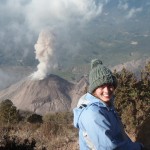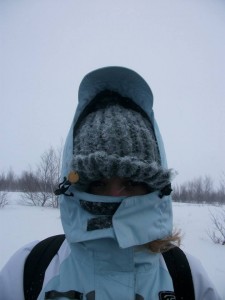 Clare Sweeney is the latest recruit to the GfGD Blog team – focusing her columns on all things related to geohazards and disaster risk reduction. Clare is a recent graduate of Bristol University’s Masters Programme in Volcanology, through which she spent time in both Guatemala and Japan. Today Clare reflects on the recent World Conference for Disaster Risk Reduction. Here are her thoughts on some key take home messages…
Clare Sweeney is the latest recruit to the GfGD Blog team – focusing her columns on all things related to geohazards and disaster risk reduction. Clare is a recent graduate of Bristol University’s Masters Programme in Volcanology, through which she spent time in both Guatemala and Japan. Today Clare reflects on the recent World Conference for Disaster Risk Reduction. Here are her thoughts on some key take home messages…
The devastation left behind by Cyclone Pam, poignantly highlighted the need for urgent action at a key opportunity for change – the week the Hyogo Framework for Action was being reviewed at the World Conference for Disaster Risk Reduction. No one can deny the need to defend our world from the ever increasing impact of natural hazards. Whether these increased impacts are down to climate change, increased exposure, or a combination of these and other factors – the conclusion remains the same. The world is changing fast and we need to protect our global community. To do this effectively we must share our ideas, help each other out, and review models of best practice – to communicate and build a resilient global network.
So what are some of the take home messages from the World Conference and the Post-2015 Framework for Disaster Risk Reduction?
‘5-10-50’
The United Nations Development Plan will support countries and communities to deliver better risk-informed development, and targets 50 countries over 10 years, with a focus on five critical areas: risk awareness and early warning; risk-governance and mainstreaming; preparedness; resilient recovery; and local/urban risk reduction.
Resilient people, resilient planet
Governments are now recognising the potential of their people and acknowledging the success stories. The conference opened with a great example from Regina Pritchett speaking about the Camelia development group. The community are located in a relocation settlement just outside of Miyagi, Japan, an area destroyed by tsunamis. The people have found innovative ways of fundraising from which the money is used to line the escape route with Camelia bulbs, a native flower which can survive saline waters and flowers as regularly as a tsunami may hit the area. They get the children involved in planting the bulbs to educate for an intergenerational movement of resilience; in the hope the lessons learned will never be forgotten – a notion reiterated by Plan International.
Build back better
Some of the hardest lessons to learn are those which we need to take the most notice. Opportunity arises in adversity. The most striking thing I noticed in the ‘build back better’ video shown at the conclusion of the conference is the strength gained in working together and learning from each other. Japan wants to show gratitude to everyone who helped them during the 2011 crisis and show that they have come out stronger because of this support.
It is sometimes an overwhelming and uncontrollable force of nature which inspires friendships and armistice. For example in Aceh, Indonesia, after almost 30 years of fighting between GAM rebels and government officials the devastation caused by the 2004 tsunami triggered the reset button. The need for aid and regeneration stimulated both sides to reach a peace agreement and work together for the good of the region. The opportunity was used to build back better.
Open access, it’s everyone’s responsibility
It is more important than ever that we, as a global community, share our ideas on Disaster Risk Reduction. As eloquently quoted by Mary Robinson and Gro Harlem Brundtland in their article for the Guardian regarding Cyclone Pam “No man is an island,” – John Donne. It is our responsibility to make a change.
But how can we contribute to this movement as individuals? Not everyone can become a humanitarian aid worker but there are still ways we can get involved! We can donate money or time to the NGO’s who work in developing countries; we can ask our government to support international aid; but did you know we can help out directly with projects just sat at our laptops? As many following this blog will be geologists, I’d expect a lot of us to have some experience with mapping software like GIS (Geographic Information System). Even if you don’t, the solution is easy: open access mapping. Every time a crisis hits there is a call for information on that area. Natural hazards destroy roads and buildings meaning aid workers have a limited knowledge of road access and areas which still need to be reached. But the great thing is that through producing maps from satellite images the teams can respond faster and more efficiently. Join Open Street Map and then see what projects are high priorities with the Humanitarian OpenStreetMap Team (HOT). It’s easy, just sign up to open mapping and watch this brilliantly simple to follow tutorial from MapGive. You can do it anywhere, even while watching the rugby. Give it a go and help out an area in need!

Wild weather hits Iceland this March causing chaos for the tourism industry and authorities. (Credit: Annabel Cooper)
—
It is no longer good enough to assume there is nothing we can do to protect mankind from the power of nature. Every corner of the globe is getting hit – from cyclones to fires, right down to freak weather conditions like the Arctic storm which hit during my trip to Iceland last week. I ended up snowed into the Blue Lagoon drinking hot chocolate and defrosting the icicles from my hair after being forced out of the hot springs by the gale-force winds (feeling a little whiplashed and with brain freeze). Outside the powerful winds were causing the authorities much bigger problems – the worst weather seen in March for years, even the locals who are used to dealing with bad weather looked taken aback. Roads were closed as vehicles were being blown off the roads and caught in snow drifts, there were unprecedented levels of ice, and it caused chaos for the tourism industry on which Iceland so heavily relies. It was a gentle, but helpful, reminder that as a planet, we’re in this together.
